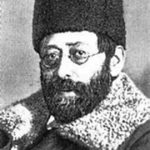The Emperor Franz-Josef of Austria and Hungary was one of the last really powerful heads of state in Europe who was not only a monarch but a statesman. He married a beautiful young German girl from Munich on April 24th, 1854, when she was just seventeen.
Elizabeth, always known as ‘Sissi’ was the daughter of a Bavarian duke called Maximilian Josef. In Court circles she met Franz-Josef in 1853, when he was twenty-three. Franz Josef was always an ardent admirer of female looks, and those of Sissi were spectacular. It is said that she fell in love on the spot, though the future emperor took a little longer. Looking back with hindsight, perhaps it might have been better for all those concerned if he had taken longer to make up his mind; Sissi might have married someone else. Very soon after their splendid marriage she began showing that restless nervousness that was supposedly typical of the Wittelsbach family, to which she belonged. Though always popular with her subjects, the same could not be said where the high society of Vienna was concerned. They found her frivolous and said so.
What the Court took for frivolity was in fact Elizabeth’s reaction to the rigid etiquette and severe dignity prevalent in Austrian high society. In reality she was simply a high-spirited girl who loved and needed fun, and it cannot have been a bowl of gay roses being married to anyone as stuffy as Franz Josef, who might be said to have been born at the age of eighty. Indeed, it was the frightful atmosphere that existed between the emperor and his son and heir that resulted in the latter’s twin suicide with his mistress at Mayerling (q.v.)
The Hungarians, for their part, liked Sissi infinitely more than the Austrians, and she spent much of her comparatively short life at a place called Gödólló, north of Budapest. She said (loudly and in Vienna) how happy she was to be in Hungary – and this may not have encouraged the Viennese to sympathise, but she managed to assuage their hurt feelings by her ardent and caring work with the wounded in the Seven Weeks’ War of 1866.
With the suicide of her son Crown Prince Rudolf at Mayerling, and the gossip associated with it because mystery surrounded the event (Rudolf may have shot his lover himself, and then put an end to his life), Sissi’s decline was rapid. Historians agree that she never fully recovered from the violent death of her only son.
In 1898, during a private visit to Switzerland, the Empress was stabbed to death in a park by an Italian revolutionary called Luccheni. The motive for the murder remains unclear. One can only deduce that assassinations of royal personages were rife at the turn of the century, and perhaps Luigi Luccheni thought that by killing Sissi he was striking a blow for Austro-Hungary’s freedom from the ageing Emperor and his antiquated dislike of social reform. He survived until 1916, at eighty-six years of age, or six, depending on your point of view.










I am watching the first DVD of “Sissi” , starring Romy Scneider. I’d heard of “Sissi” but didn’t read much about her – but now I plan to. I had heard of “Mayerling” through the paranormal researcher, Hans Holzer’s story on it and the haunting associated with the deaths there. I can’t wait to read more about Sissi’s life now.
Thank you.